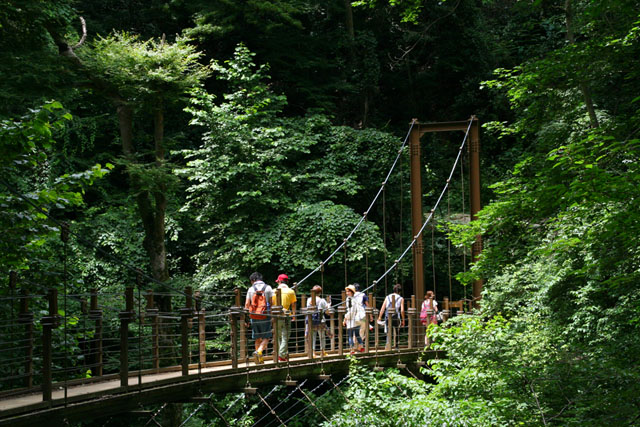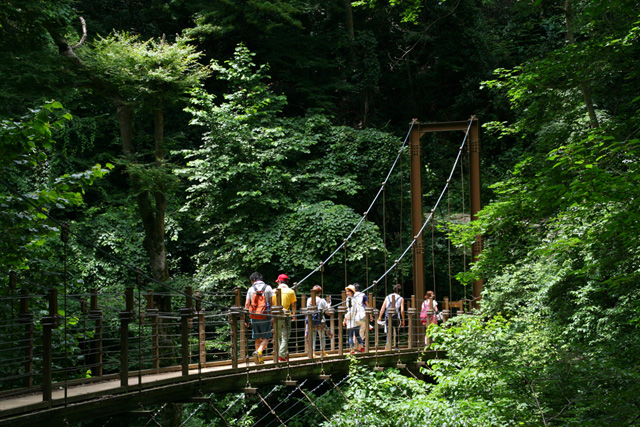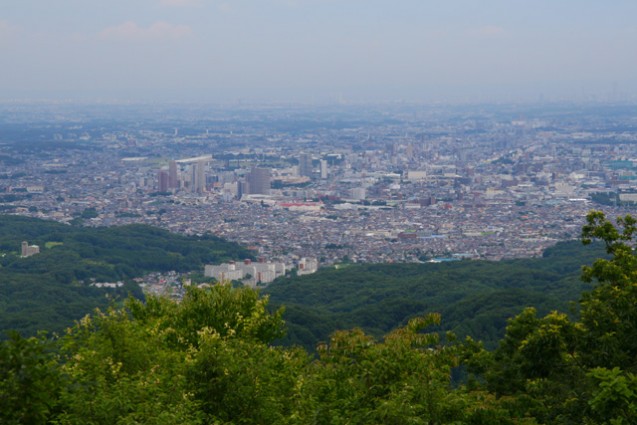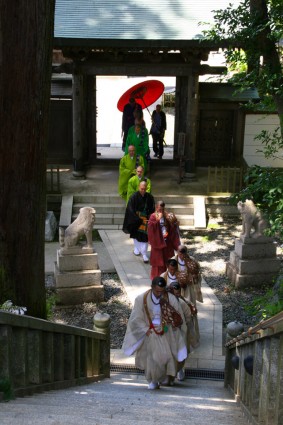Hiking at Mount Takao is something many of us here in Tokyo will have done at some point or will do in the future – it’s convenient for most of us to get to, relatively easy to scale, and offers some stunning views… One writer found more than expected on his first trek out west.
by Andrew Ng
“It’s not a real mountain,” they scoffed. “It’s not even 600 meters high!”
Great, I replied.
“In fact, it’s not even in the real countryside; it’s barely one hour from Tokyo.”
So much the better, I laughed.
“And what’s more, real mountains don’t have cable cars or chairlifts that take you halfway up.”
Perfect. I was already on my way.
Accessing Mt Takao is really easy: it’s about 50 minutes on the Keio Line from Shinjuku to Takaosanguchi station, at the base of the mountain, or you can take the JR Chuo Line to Takao station and transfer to the Keio Line for one more stop.
Takao-san, as it’s called in Japanese, is 599 meters high. Not that high, certainly, but whatever my friends might have said, it’s full of trees, rocks and plants, not to mention a stream, which certainly makes it seem like a real mountain to me. In 2007 it received the maximum three stars from Michelin’s travel guide book, Voyager Pratique Japon.
Yes, it’s true, there is a cable car and a chairlift at Mount Takao, but that isn’t a bad thing. It means you can get up the mountain quickly to spend a pleasant half day in rural surroundings, which makes it an ideal city getaway.
Of course, you can spend all day there too if you wish, which is what I did.
The Trails of Mount Takao
There are six numbered hiking trails plus the Inariyama trail, all clearly described in English on the official website. Starting from the foot of the mountain on either side of the cable car station, choose the Inariyama Trail, or Trails 1 or 6 if you want to hike from the base to the summit. Trails 2 and 5 are short loops, each of which takes about 30 minutes to walk.
Trail 5 circles the summit, whereas Trail 2 travels around a Monkey Park and Wild Plant Garden, halfway up the mountain. It’s a particularly useful trail, since you can hike from here to the summit via Trails 1, 3 and 4.
Yakuo-in Temple
Mount Takao is a sacred mountain, and an impressive Buddhist temple, Yakuo-in, was established there in 744 by the priest Gyoki.
“If you have experience as a Himalayan sherpa, you’ll have no problem in sneakers or beach sandals. If not, I would advise you to wear sturdy sports shoes or boots, especially if there has been recent rain.”
Restored in the late 14th century by Shungen Daitoku, it was further expanded with support from the Tokugawa shogunate during the Edo period (1603-1867).
You really shouldn’t miss this. It lies on Trail 1, which is paved all the way from the trail-head to the temple, and thus the easiest hike on the mountain. It’s perfectly fine to wear sneakers on this trail.
The Mt Takao Suspension Bridge Trail
After visiting Yakuo-in and witnessing a procession of Buddhist priests blowing on conch shells, and the chanting of ritual prayers in the temple, I tracked back for 10 minutes along Trail 1 and headed off to the summit via Trail 4, also known as the Suspension Bridge Trail.
This trail is flat until you get past the suspension bridge, after which it climbs steeply for a while. Log steps have been laid at various points along this trail, but it is also scarred with the knotted, exposed roots of beech trees and can be narrow in places.
I found the steps hard work and preferred to climb along the side. If you have experience as a Himalayan sherpa, you’ll have no problem in sneakers or beach sandals; if not, I would advise you to wear sturdy sports shoes or boots, especially if there has been recent rain. On weekends, all the trails can get crowded, so watch your step; it’s a steep fall if you lose your footing on the narrower parts of the ridge.
The view from the summit is refreshing and reminds you why you came. On a clear day you’ll be able to see Mount Fuji, which also received three stars in the Michelin book and was recently inscribed as a World Heritage site.
Treat yourself to a beer and soba noodles if you like, but expect the summit to be packed on weekends. I chose a Friday, which was perfect – there was no waiting at all. If you prefer your mountains to be a lot less crowded than Shinjuku station, you’ll choose a weekday too.
The Biwa Waterfall Trail
To descend, I followed Trail 6, the Biwa Waterfall Trail. This trail tracks the Biwataki Stream, which you sometimes find yourself stepping through. Don’t worry, it’s shallow. If you wear waterproof hiking boots you won’t have to worry too much about where you step and you won’t have to wait in line to take advantage of the slab-like stepping stones – again, I advise you to choose a weekday if you can. The descent takes about 70 minutes and can be quite narrow and knotty.
“If you prefer your mountains to be a lot less crowded than Shinjuku station, you’ll choose a weekday too.”
At times you’ll find yourself clambering over the mangrove-like tentacles of exposed cedar roots so be especially careful not to twist an ankle. I chose this route because I wanted to see the Biwa waterfall.
On the first Saturday of each month, ascetics don white robes and chant mantras under the falling water.
It’s only a small waterfall, and to my surprise I walked straight past it, only realizing this when I reached the Iwayadaishi Cave. Within a few minutes I was at the end of the trail and back at the cable car station.
Soba On the Slopes of Mount Takao
As an Englishman, there was nothing more refreshing than a hot, sweet cup of tea from one of the vending machines on the station forecourt, even though it was a scorching day. Then it was off to Momijiya for tempura soba. This restaurant specializes in grated yam (tororo) soba and was established in the Meiji era, in 1894 (Meiji 27). A menu in English is provided if you need one, and a bowl of soba will cost between ¥900 and ¥1,200.
Sated, there was only one thing left to do: buy omiyage. From the variety of shops that line the two streets between Keio Line Takaosanguchi and the cable car station, I bought wasabi rice crackers, anko mochi and manju.
My trip was over. I had started at 9:15am and finished at 3pm but this was a leisurely hike, with plenty of time spent taking photographs.
The mountain was quiet and I encountered only a handful of people on the unpaved trails, each time passing with a customary “konnichiwa”.
Vending machines at the top and bottom mean you won’t run out of water, but be prepared to take your garbage back with you. Mount Takao receives over 2.5 million visitors per year, which adds up to a whole heap of empty plastic bottles, so no garbage bins are provided at the summit.
In truth, my friends didn’t scoff that much and it was only in jest. Mount Takao is the perfect city escape. You can spend a morning or an afternoon there, or take all day to hike a variety of trails. Catch your breath amongst beeches and cedars, and soar over Tokyo with the view from the summit.
If you can avoid the crowds on the weekends then so much the better, but if you really can’t, don’t let that stop you. Go anyway. It’s a great escape from the built up city.
The official website for Mount Takao has a very clear map and trail information (www.takaotozan.co.jp/takaotozan_eng1/index.htm).
Yakuo-in Temple has its own website, with information on ascetism, rituals, temple etiquette and special events (www.takaosan.or.jp/english/index.html).

BOOK A GUIDED TOUR
CLIMB MT. TAKAO AND REFRESH YOURSELF IN THE BEAUTIFUL NATURE
For an extra 5% off use our coupon code TOKYOWEEKENDER during check-out.












